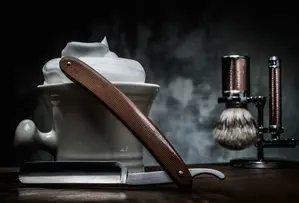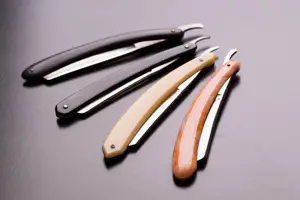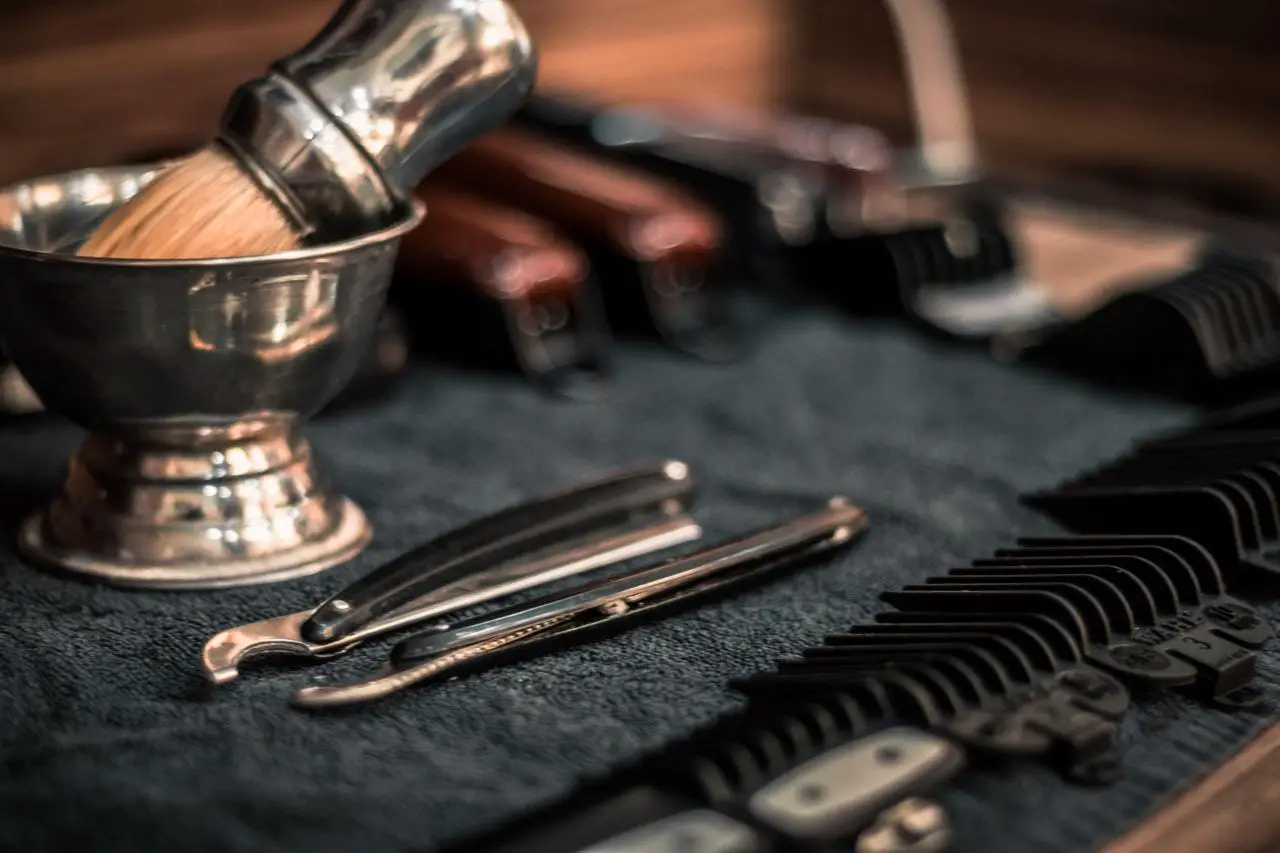Shaving is something that is most of us have to do. For men, the process is often considered a chore as in order to be clean shaven, shaving must occur most days. However, many of those who’ve ventured into the world of wet shaving have found that it can become an enjoyable experience. Some even consider it a hobby.
While the safety razor is often a popular option for shaving body hair, the straight razor prevails in shaving facial hair. The straight razor is simply so much more capable of delivering an incredibly close and smooth shave. Unfortunately, the straight razor has fallen into disuse over time, but it seems to be making a gradual comeback with more and more men appreciating the art of the straight razor once again, resulting in many people wanting to try them out.
Straight Razor Shave Guide

Of course, shaving with a straight razor isn’t as straightforward as it is with a safety razor. It takes time and effort to master the skill. While it’s more of a challenge than working with your typical disposable or disposable-blade razor, the results are incredible.
To help you along your journey to mastering the straight razor, we have created this comprehensive guide to straight razors and shaving with them. By the end of this article, you will know more than most about the art, including their history, the best way to use them, how to care for and maintain them, and so much more.
History Of Shaving
Before we get to the straight razor, let’s dispel the myth that it was the original form of shaving, because there were many other ways throughout earlier history. It just so happens that the straight razor was the first metal razor type that was used, and that is why it is associated so closely with old shaving methods.
Of course, this does not mean that the straight razor wasn’t the most popular shaving option for hundreds of years. We will be taking a look at how people shaved before the straight razor, how the straight razor came into popular use, and how it has made a comeback in the past decade or so.
Before The Straight Razor
There were a few different methods that ancient peoples used to shave before the invention of the straight razor, and they are really quite interesting. First off, you have actual clamshells that were used as if they were tweezers, with people closing them over their facial hair and pulling.

While this was sometimes used for facial hair, it was a rather uncomfortable and painful experience to rip out your beard bit by bit. This led to the development of razors that were made out of flint since it was a material that was easily sharpened using stone or another harder substance.
The Invention Of The Straight Razor
The first straight razors that were produced in recorded history were made by the ancient Egyptians around 1000 BC, but they were not made of steel. Since ironworking and steel had not been ventured into yet, Egyptian straight razors featured blades made of bronze or copper and non-folding handles.
It took until the end of the 1600s for the modern incarnation of the straight razor to make an appearance, first being produced in Great Britain. These razors caught on quickly until they gradually faded out of use due to the growing popularity of safety razors and similar designs.
The Comeback Of The Straight Razor
Luckily, the story of the straight razor doesn’t end there, as it has seen a sudden resurgence in popularity over the course of the past decade or so. You may be wondering why straight razors so suddenly came back into favor, and it is for a variety of reasons, including pricing, the closeness of shave, and the satisfaction of a proper traditional shave.
Now that the demand for straight razors is on the increase, straight razor models are far more affordable than in recent years. As the trend continues to grow, more and more brands are recreating models and bringing out brand-new designs.
What Is A Straight Razor?
While we have been discussing the history of the straight razor up until this point, we have yet to provide a concrete definition of what exactly it consists of. A straight razor has a fairly simple structure: a razor that has a straight blade, though many modern versions will have a slightly curved edge.
Most straight razors have a relatively similar design that consists of a folding blade that is stored inside the handle, making for a safe and convenient package. A lot of the time, the grip of the razor will feature scales or a rubberized insert to ensure that it doesn’t slip in your hands, potentially cutting you.
How Have They Changed Over Time?
We get quite a few questions from our readers, but none of them are as common as the inquiries as to how straight razors have changed over the past few decades. There have been quite a few advancements in all domains of shaving, and many people believe that straight razors have remained stagnant this whole time.
You may be surprised to learn that these razors are now as advanced as many of their competitors. We’re going to look at how the materials that are used in these razors have evolved, the way the ergonomics have changed, and also the improved safety features.
Better Materials
This is probably the most obvious advancement in the quality of straight razors over the course of the past few decades since it is evident that the quality of metals that we use will gradually shift. Of course, you can’t expect quality metal to be used in a bargain bin razor, but the majority now use better metal. From ensuring that the edge will last longer before you need to sharpen it to reducing the likelihood of the formation of rust, improved metal quality is a huge step forward.
More Ergonomic Handles
The handles that used to be featured on straight razors used to be as straight as the blades themselves, but with increased knowledge and awareness of the importance of ergonomics, modern designs have improved. Many handles that are made today will feature grooves or indentations for your fingers to rest in, improving comfort.
Of course, there is much more to the ergonomic advancement of these straight razors than some simple indentations. Inserts and scales have become far more common in straight razor handles to make them much less likely to slip out of your fingers during use, further improving their safety.
Safety Features
Understandably, the safety features of a straight razor have also improved, though there is only so much that you can do to make something like a straight razor safer. First off, some models feature locks on the razor blade to ensure that it doesn’t open up in your shaving bag.
Many modern straight razors aren’t quite straight anymore, featuring a slightly curved profile that reduces the surface area of the razor in contact with your skin, reducing the likelihood of a cut. The inclusion of a grippier handle can also be seen as a safety feature, as it will be less likely to slip.
Types Of Straight Razors
When deciding on the ideal straight razor, you will have to consider your shaving style and your blade preference. There are two distinct kinds of straight razors, and each one has their own pros and cons, and we’ll be looking at them in this section.
The first of these straight razor types is a more traditional option: the classic straight razor. However, there is a relatively recent form of straight razor that some may prefer to opt for: the straight razor with disposable blades. Let’s see what distinguishes these razors.
Straight Razor
This is the classic, and what everyone thinks about when they picture a straight razor. With this kind of blade, you will have to strop it to ensure that it remains sharp enough for use as it can’t be replaced like the blades on other kinds of razors. You may be wondering why you would inconvenience yourself like this.
While you will have to put extra time into stropping your blade to ensure that it remains sharp enough, a classic straight razor will often give you a much closer shave. Also, you save money when using this kind of razor as you won’t need to buy replacement blades.
Disposable Blade Straight Razors
This is a relatively modern incarnation of the straight razor, and it takes the best of disposable blade razors and combines the technology with the form of a straight razor. Since you can simply swap out the blade once it gets dull, you won’t have to spend time sharpening it if you suddenly find it too dull to shave with.
Of course, there are a few differences between these razors and traditional straight razors, which makes the choice one of personal preference. Disposable blade models often have a shorter blade than classic ones, so it may take a little longer to shave all of your facial hair, but that is offset by the lack of stropping.
Types of Blades and How They Affect Shaving
There are a few different kinds of straight razor blades, but it is largely a matter of preference once again. Most straight razors will feature a single-sided blade which is positioned on the side that folds into the handle. This is the traditional design which has been used for hundreds of years.
Another popular form of straight razor is the Japanese Kamisori, which is made through a unique metal grinding process. Unlike the usual type of straight razor, the Kamisori features one side that is fully sharpened while the other is only slightly sharpened, giving you a few options.
How To Use A Straight Razor
This part of the guide is one that many of our new readers are likely interested in, as using a straight razor can be an intimidating experience. We’ll give you a comprehensive guide to using one of these razors.
Of course, you have to consider that there is more to using a straight razor than just shaving with it, as maintenance is also an important element of using these blades. We’ll advise you on some of the best ways to strop these razors, and we’ll also provide some recommendations for applying shaving cream and lather.
Straight Razor Shaving
When you shave with one of these razors, you need to be much more careful than you would with a safety razor, and you will have to focus far more on your movements. While shaving with other razor types is a mindless task, keeping track of where you have shaved is vital.
If you want the closest possible shave, you will have to go with the grain of hair growth for the first two or three passes, and only then can you go against the grain. Neglecting the initial stages of shaving in the direction of hair growth will result in nicks and cuts.
Stropping
To beginners, stropping and sharpening your razor may seem like the same thing, but that is not the case. While both of these processes help to keep your blade sharp, stropping is essentially the final touch you put on the edge to ensure that it is ready to shave you as effectively as possible.
As you use your blade, it gets duller, but also bent out of shape, and stropping helps alleviate both of these issues. Using a leather strop, you will have to run your razor blade along the leather at an angle, ensuring that both sides get the same amount of attention to keep them equally sharp.
What Type Of Shaving Cream Or Soap To Use?
When you are shaving with a straight razor, you can typically use any shaving cream, but it will be a challenge to get the closest shave unless you are using the best. You will most likely want to opt for shaving lather that is meant for use with straight razors specifically.
Of course, there is more to shaving with a straight razor than just using the right shaving cream, as you will also want to make adequate use of aftershave and perhaps even beard oil. If you have grown out a beard and you want to tackle it with a straight razor, it will be much easier if you have taken care of your facial hair.
So Why Use A Straight Razor Today?
To many, the process involved in using a straight razor is off-putting, but for those who are invested – the results are worth the extra effort.
In this part of our guide, we’ll be going over the differences between a straight razor and many other kinds of razors that are currently used for shaving. Each option will have its own pros and cons.
Straight Razor Vs. Safety Razor
Many people aren’t aware of the difference between a cartridge razor and a safety razor, and there are some important distinctions. Foremost, amongst the differences is that the safety razor features a single double-sided blade, which makes shaving easier as more hair will be cut in each pass.
How does a safety razor stack up against a straight razor? Well, both of these razors are quite similar, though the straight razor will have a larger surface area, making it easier to shave more facial hair in a single pass. An advantage for the safety razor is (of course) its relative lack of risk.
Straight Razor Vs. Cartridge Razors
It is likely that all of our readers are acquainted with cartridge razors, which are essentially a mix of the safety razor and the disposable razor, giving you the best of both worlds. These razors feature disposable blade cartridges (featuring several blades in a row) that can be replaced once the edge has worn off of them.
When compared to a straight razor, you will find that cartridge model provides nowhere near as close of a shave, which is unfortunate as they are quite convenient. Many cartridge razors feature additional features like vibration or strips to tell you when your blade has grown dull enough for replacement.
Straight Razor Vs. Disposable Razors
Disposable razors are at the most affordable end of the spectrum, as you can pick up a bag of these razors for a fraction of the price of another type. Disposable razors are simple discarded when dull.
Comparing a straight razor and a disposable razor is challenge, as they are designed for entirely different purposes. While the straight razor is more expensive, permanent and more effort to master, it gives you the closest shave. On the other hand, disposable razors are designed to be cheap and convenient – however they don’t produce a particularly close shave.
Straight Razor Vs. Electric Razors
Finally, we reach the electric razor, which many people see as the most versatile shaving implement as it can be used on your head as well as your facial hair. Electric razors are an excellent choice if you are not looking to put much effort into your shaving, as you can just run it along your face.
While electric models may be more versatile than the straight razor, they still lack the closeness of the shave that you get from them. Straight razors also often have the advantage in price point, as a quality electric razor set can often set you back nearly 200 dollars, though you won’t have to sharpen it.
Straight Razor Maintenance
Keeping your straight razor properly maintained is one of the prime considerations you will have to make if you plan on switching to this kind of shaving. There are a few steps to ensuring that you have the best shaving experience every time, and we have already touched on some of them.
In this part of our guide, we’ll be looking at the importance of keeping your blade sharp, stropping it, and much more. By the time you are through with this section, you should be ready to own a straight razor, as we have covered just about everything else you need to know about these blades.
Sharpening And Cleaning
Keeping your blade sharp is integral to the effectiveness of a straight razor, and you will want to use a specially made sharpening stone to do so. Of course, you will also need to keep your blade clean, which can be accomplished with simple soap and warm water. You should always clean your blade before sharpening it.
Strop
Stropping your blade is the process of running your razor over a strop (which is a strip of leather) to ensure that the blade is straight. Stropping also helps remove any metal shavings that may remain on the blade after you have sharpened it.
Hone
Honing your blade is the last step of the process, and it entails going over the razor with a cloth to give the edge its final sheen. Once your blade is shiny and polished, you will be ready to shave with it.
Conclusion
Now that we have covered everything that you need to know about the straight razor, feel free to move on to our buying guide, an article in which we review the top five models on the market. Thank you for taking the time to go over this guide, and feel free to leave us a comment down below.
Resources:
